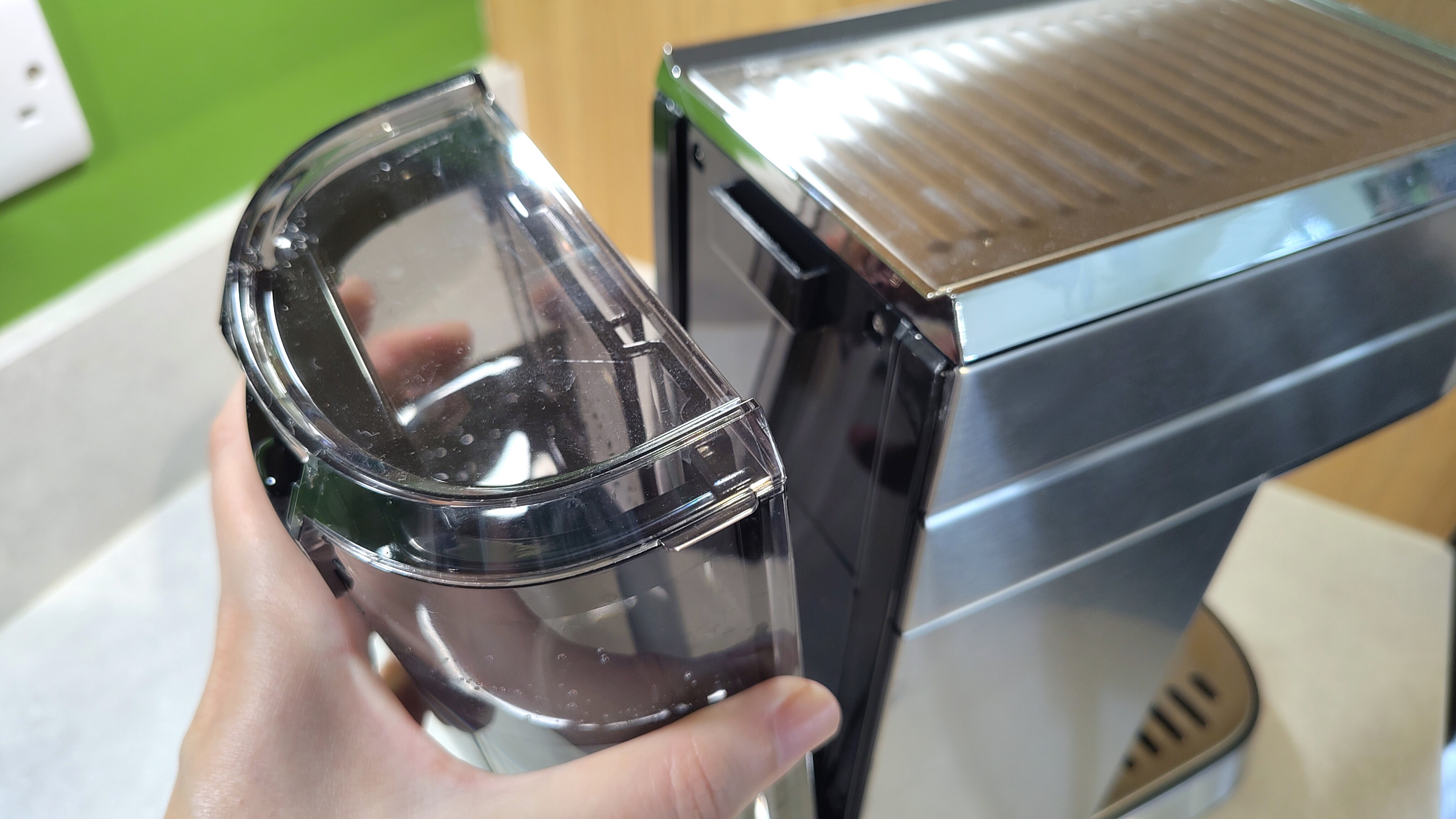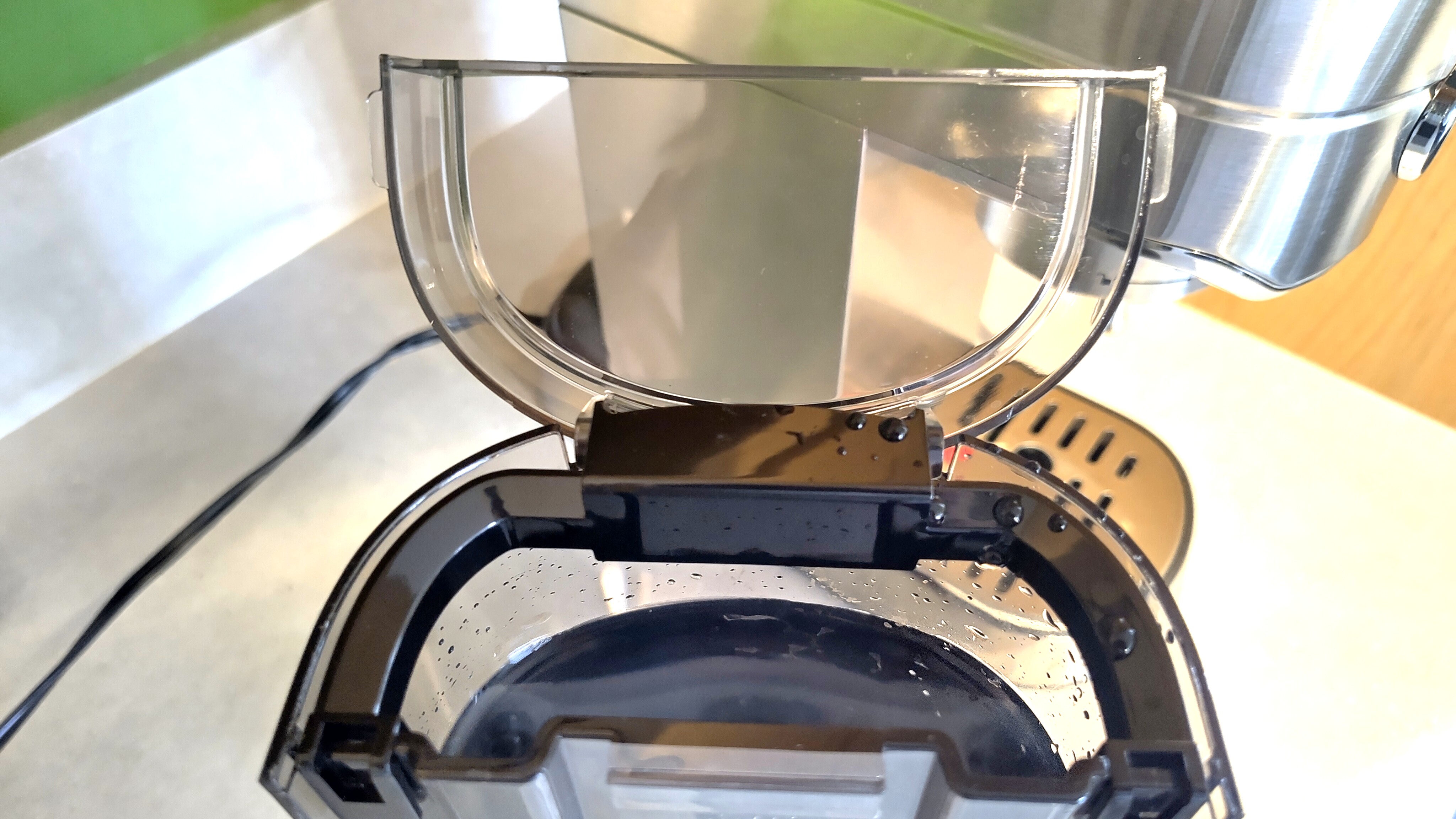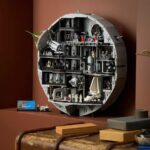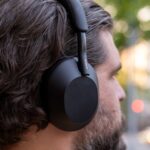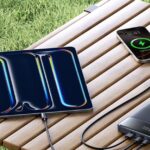Why you can trust TechRadar
We spend hours testing every product or service we review, so you can be sure you’re buying the best. Find out more about how we test.
Casabrews 5418 Pro: one-minute review
The Casabrews 5418 Pro espresso machine is compact, lightweight, and easy to operate via physical buttons and a simple lever to control all its functions. A pressure meter on the machine’s face helps guide extraction; but the pressure can be inconsistent, leading to under-extracted espresso.
This inconsistency may well be down to the boiler, but it’s further hindered by the lightweight plastic tamper, which makes it difficult to exert much pressure on the coffee puck. The portafilter also feels rather flimsy, and with no clip to keep it in place, the filter basket had a tendency to fall out when I was knocking out used grounds.
On the positive side, the 5418 Pro heats up quickly, and the shot volume can be manually configured to compensate for any drips once the pump has finished. The steam wand is also a highlight, with a good range of movement and a cool-touch silicone handle. The machine can also dispense hot water for tea, which is handy.
My first impressions were overwhelmingly positive, but the more I used this machine, the more it became apparent where corners had been cut to keep the price so low.
Casabrews 5418 Pro: price and availability
- Launching late August 2025
- List price $299.99 (about £220 / AU$460)
- About the same price as Breville/Sage Bambino
At the time of writing, the Casabrews 5418 Pro has yet to be officially launched. It will go on sale on August 26, 2025, with a list price of $299.99 (about £220 / AU$460). However, there will be a $120 launch coupon, bringing that price down to just $179.99 (about £130 / AU$280) – and, ahead of its launch date, Casabrews is offering pre-orders for an early bird price of $159.99 (about £120 / AU$250) at Amazon.
The Breville Bambino (known as the Sage Bambino in the UK) is a compact espresso machine sporting roughly the same specifications, and has a similar list price at $299.95 / £329.95 / AU$449.95. The Bambino has been around for several years, and can usually be found steeply discounted on Black Friday and Amazon Prime Day. Check out our full Sage Bambino review for more details.
Casabrews 5418 Pro: specifications
|
Name |
Casabrews 5418 Pro |
|
Type |
Semi-automatic espresso machine |
|
Dimensions |
12 x 5 x 11 inches / 30.5 x 13.5 x 28cm |
|
Weight |
7.2lbs / 3.27kg |
|
Water reservoir capacity |
34oz / 1 liter |
|
Steam wand |
Manual |
|
Max pressure |
20 bars |
|
User profiles |
N/A |
Casabrews 5418 Pro: design
- Very compact and lightweight
- Physical buttons rather than touchscreen
- Accessories feel somewhat flimsy
The Casabrews 5418 Pro is extremely compact, and very light, making it ideal for small kitchens; you can easily tuck it in a corner and move it around, if necessary. It measures just 12 inches / 30.5cm tall, 5 inches / 13.5cm wide, and 11 inches / 28cm deep. That’s tiny enough to fit on my kitchen scale, which confirmed that it weighs around 7.2lbs / 3.27kg including its power cable and plug.
I was testing the North American version. The UK model, when it launches, will be slightly heavier as a result of the bigger fused plug.
The water tank lifts easily out of the back of the machine, and has a robust handle that makes it easy to carry to and from the sink. There’s no water filter provided, but I wouldn’t expect that for such an affordable espresso machine. Casabrews doesn’t currently appear to sell filters for this machine, but you could fill it with filtered water, if you like. Just don’t use distilled water; it’s not good for any coffee machine, and can cause problems with the water-level sensors.
There’s no touchscreen here; instead, all the controls are in the form of physical buttons arranged along the front of the 5418 Pro: power, single shot, double shot, and steam. The steam wand is operated using a lever on the right-hand side of the machine, which feels a little lightweight in the hand, but works perfectly well. The wand itself has a good range of motion, and a heat-resistant silicone grip, so you can adjust it safely without burning yourself.
On the front of the machine you’ll see a pressure meter, which is a helpful guide to help you see whether your espresso shot is likely to be extracted correctly. The pressure goes up to 20 bars, but you’re aiming to be around nine when pulling a shot. It’s worth noting that this is the pressure at the boiler, and will likely be higher than the pressure at the group (where the hot water is forced through your coffee grounds).
The Casabrews 5418 Pro comes with just a handful of accessories: the portafilter handle, a pressurized double-shot filter basket, and a plastic scoop with a tamper on the end. According to the instruction manual there should also be a single-shot pressurized filter basket, but this wasn’t present with my review sample.
The portafilter is different to any I’ve used before, because it doesn’t have a spring clip to hold the basket in place. Instead, you place the basket in the handle and rotate it to fasten it in place. This was presumably a design decision made to keep costs down.
The tamper is super light, and you may find it tricky to tamp your coffee grounds hard enough – although it helps that the portafilter handle has silicone ridges on the base that help stabilize it on your countertop. I have my own wood and metal tamper, which I would have tried for comparison, but it’s too large for the 51mm basket.
There’s no milk pitcher provided with the machine, so you’ll need to buy one separately. Look for one with a fine spout if you want to try your hand at latte art.
According to its Amazon listing, the 5418 Pro will be available in two colorways (Silver and Metallic Gray); but at the time of writing, only the latter is available to pre-order.
Casabrews 5418 Pro: performance
- Heats up very quickly
- Initial results were promising
- Inconsistent extraction (sometimes under-extracted)
- Lots of dripping after pouring a shot
I wanted to love the Casabrews 5418 Pro, and my initial impressions were very positive. My first attempt at brewing a shot with the 5418 Pro turned out well, and I was pleasantly surprised at how well the espresso was extracted. Foaming milk was a piece of cake, and within a couple of minutes I was enjoying a very pleasant latte.
Unfortunately, this wasn’t always the case, and the 5418 Pro sometimes struggled to reach the optimal nine bars of pressure, leaving me with under-extracted espresso, even when I set my Sage Dose Control Pro grinder to its finest setting. I’m quite sure from experience that my grinder wasn’t the limiting factor, so it may have been the pump, or it may have been due to me struggling to apply sufficient pressure consistently using the plastic tamper. If you choose to pick up this machine, I’d recommend investing in something sturdier.
I also didn’t love the clipless portafilter, since the basket tended to fall out when I was trying to knock out the used puck. Fishing a hot filter basket out of a food waste bin is nobody’s idea of a good time.
On the plus side, Casabrews’ claims that the machine can reach temperature in just a few seconds proved accurate. The 5418 Pro comes with a sticker warning you to pre-heat the groupset by running hot water through it without the portafilter attached, and another note to the same effect in the instruction manual – but this is good practice with any espresso machine. I certainly didn’t experience any problems with cold espresso during my testing.
The double-shot pressurized basket certainly creates lots (and I mean lots) of crema, but I’d be curious to use the single-shot basket as well.
Like the Breville/Sage Bambino, the 5418 Pro tends to dribble coffee after the pump has stopped, presumably for the same reason – the lack of a three-way solenoid valve. If you own the Bambino, you can get around this problem by using the manual shot button. This lets you choose how long the pump runs, and you can stop it early so you don’t end up with too much espresso.
There’s no such button on the Casabrews machine, but if you’re finding yourself with too much espresso, you can configure the shot volume manually. To do this, press and hold either the single or double espresso shot button for three seconds (depending on which one you want to customize), then press it once to start the pump. Once you’ve reached the desired amount of espresso, press the button again to stop the flow. The machine will then remember this setting and re-use it next time.
You can also use the Casabrews 5418 Pro to dispense hot water for tea, which is a nice feature that you won’t find on all espresso machines.
My only other criticism is that the 5418 Pro’s beeps sound somewhat tinny, which is perhaps a strange thing to complain about, but it does add to the overall impression that this is an espresso machine made to a strict budget.
Should you buy the Casabrews 5418 Pro
|
Attribute |
Notes |
Score |
|---|---|---|
|
Value |
One of the most affordable home espresso machines I’ve tested, with early bird discounts available too. |
5/5 |
|
Design |
Compact and light, but some unsatisfying design decisions have been made to keep the cost down. |
3.5/5 |
|
Performance |
Initially performed well, but proved inconsistent with continued use. |
3/5 |
Buy it if
Don’t buy it if
Casabrews 5418 Pro: also consider
If you’re not sure whether the Casabrews 5418 Pro is the right espresso machine for you, here are two alternatives to consider.
How I tested the Casabrews 5418 Pro
I used the Casabrews 5418 Pro for two weeks in place of my usual coffee machine, and brewed coffee using a blend of freshly roasted Brazilian and Colombian arabica beans. When my shot wasn’t properly extracted, I adjusted the grind size of my Sage Dose Control Pro grinder to compensate. I used the tamper provided with the machine to tamp the coffee. I tested the steam wand with fresh, full-fat dairy milk and oat milk.
I flushed the machine with hot water before and after brewing (to preheat and cool it respectively). I purged the steam wand and wiped it with a damp cloth after making each drink.
For more information, see how we test, rate, and review products at TechRadar.
First tested August 2025
Read the full article here





